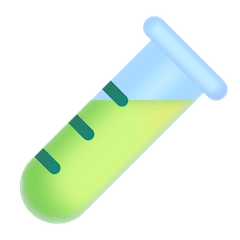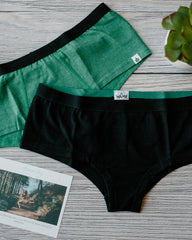
The Lowdown on Eco Fabrics
The world of eco fabrics is full of so many possibilities with both natural and synthetic options – and with my mission to bring you eco-friendly products, I wanted to take a deep-dive into the fabrics I carry and why.
Let’s get into it!
The next most important element to me (besides style, fit, and comfort) is that each product is made with fabrics and dyes that are as eco-friendly as possible. This is the second part of a product being eco and ethically sourced. It should be safer for people and for the planet.

When it comes to fit for some more specific items like a smooth-cup t-shirt bra, this can be a challenge. In order to help you get the best fit for items like these, synthetic fabrics that aren’t so green are still the only way to get the right shape and fit. For items like these, I make an exception. I carry a few items that meet the style + fit criteria that you’re looking for, but I’m still looking to replace those products in the future with more eco versions!
Despite these challenges, I have managed to find some amazing products in some amazing eco-friendly fabrics. I’ve found both comfy basics and gorgeous specialty styles that fit both of my requirements for ethical, eco-friendly fashion!
Below I’ll go into a little more depth about all the different nuances and differences in the natural, synthetic, and recycles fabrics you can find in the lines I carry.
 Synthetic Fabrics
Synthetic Fabrics
Synthetic sounds bad, and it generally is, but high-tech fabrics have some wonderful uses for longevity and function (hello winter parkas!). Yes, natural is preferred and some synthetics are better than others, so it’s important to know what is used in the production of synthetic fabrics.
Polyester/polyamide
Polyester and polyamide are synthetic fabrics that take much longer to degrade than natural fibres (because it's derived from oil and basically plastic 😖) . The dyes used to colour these fabrics are also often harmful to the environment (looking at you, neon!). However, polyester holds its shape and lasts a long time, and is a versatile tool to create shape-wear like smooth cups for t-shirt bras or beautiful laces (which is why you may notice that recycled lace or items made with recycled plastic bottles have a higher $$$ due to the extra energy to create it vs. virgin polyester). My intention in carrying a few products made with synthetics is that they will be extra functional or comfy pieces that will last a long time.
Blends of polyester / polyamide / nylon / elastane spandex / sometimes mixed with viscose rayon or cotton
Blends allow for a natural fibre element in a garment which is great, but they still take longer to recycle/break down in the landfill. However, I believe a blend of spandex/elastane into an eco-friendly fabric like organic cotton will help retain the shape and comfort of your undies and therefore ensure you enjoy them longer!
Organic Bamboo (closed loop)
Yep, bamboo is actually considered a synthetic material 😱. They are treated with so many chemicals that the pulp compounds become synthetic. The chemicals used in bamboo can sometimes make it a controversial choice but I still vote it’s better than oil-based polyester. My suppliers choose organic/closed loop so that reduces the chemical impact. This means that the production of the bamboo fibres only produce half as much hazardous waste. Other benefits of this eco-fibre:
- requires less water than cotton
- easy and quick to grow
- doesn’t require the use of pesticides
🌿 Natural Fabrics



The following are from eco-friendly natural fabrics that I carry and a bit more of an in depth explanation into why I seek out these fabrics over others!
Organic Cotton
While regular cotton is known for being extremely wasteful when it comes to water use for production, organic cotton is a much better option. Here are a few reasons why it’s a more eco-friendly choice:
- Made from natural fibres
- No use of pesticides or chemicals in its production
- Biodegradable
- Moisture/sweat wicking
- Breathable
- Soft and cozy
- Produced with fair trade labour
Organic Hemp
So many of my shoppers are in love with the Wama Underwear line that we carry! And it makes sense since there are lots of reasons to love hemp when it comes to making a good environmental choice. Here are just a few:
- Natural fibre
- Naturally anti-bacterial
- Anti-microbial with anti-odor properties
- Super comfortable, and breathable
- Hemp gets softer with every wash
- No chemical processing required
- Requires less water than cotton
- Requires little to no pesticides
Tencel/Lyocell
This fibre makes a soft, breathable, easy-to-wear fabric! Here’s why I like it:
- Naturally biodegradable
- No harmful byproducts during production
- Quick growing (ours is from sustainably harvested eucalyptus trees in Europe)
- No pesticides required
- Breaking down the fibre can be done with a recyclable chemical
♻️ Upcycled & Recycled Fabrics
Natural fibres can use up a lot of resources to produce, while synthetic fibres are at their base, plastic, and take a long time to degrade. Another type of fabric that can be a great alternative are recycled or upcycled fabrics!
Recycled fibres can be taken from old clothing, or completely spun new from breaking down old materials like plastic bottles. The fashion industry is slowly getting more creative and now wool and other fibres that are easier to sort (they need to contain 100% of a single type of fibre) are able to be recycled from old clothing into new.
Some designers, like Preloved Toronto use thrifted clothing to create brand new pieces. Basically, as long as the fabric is being used for a second purpose instead of being tossed, it can be considered upcycled.
Here’s a bit more information on some of the types of recycled materials you can find in the lines we carry.
Recycled Nylon
You can find this fabric in our swimwear collections and in some pieces as a recycled spandex blend, such as in Sokoloff’s organic cotton collection! In our swimwear lines is recycled nylon from discarded fishing nets pulled from the ocean, (which are terrible for harming innocent ocean creatures and actually more frequently found in the ocean than single use plastics). Again, it’s all about reusing what already exists on the earth when it comes to synthetic fibres.
Recycled Polyester Lace + Mesh
A lot of the lines we carry that add lace or mesh embellishments on the cute garments you love so much use recycled polyester lace! This is so much better for the environment and makes these products a lot more sustainable.
******************************************************************************************************
I hope this post gives you a little more perspective on the thought that goes behind how I source and choose different products that I carry here at Azura Bay! The world of eco-friendly fabrics can be complicated but I really think it’s worth it to educate yourself on how and why you choose your lingerie, and really any piece of clothing, and what goes into each item when it comes to materials. I know I’m not perfect, but I’m always working to make sure the items I source are as eco-friendly as they can possibly be while offering the best fit and comfort for my customers.

![]() Pin me to use whenever you're trying to double check a fabric 😉👇🏻
Pin me to use whenever you're trying to double check a fabric 😉👇🏻
